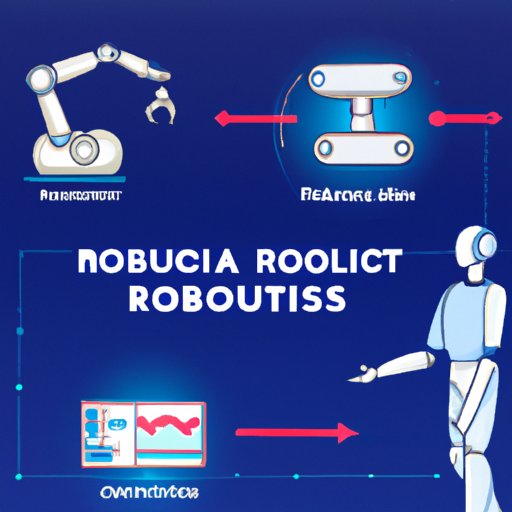Introduction
Robotic automation is an emerging technology that is transforming the way businesses operate. In its simplest form, robotic automation is the use of robots or automated systems to complete tasks that would otherwise be done by humans. This technology has revolutionized many industries and enabled businesses to reduce costs, improve efficiency, and increase productivity.
Exploring the Benefits of Robotic Automation
Robotic automation offers a wide range of benefits for businesses. Here are some of the most common advantages:
Increased Efficiency
Robots are designed to be more efficient than humans in executing repetitive tasks. By automating mundane tasks, businesses can free up their employees to focus on higher-level work, such as strategy and innovation. According to a study by The Hackett Group, companies that implement robotic automation technologies have seen an average reduction of 15 percent in labor costs and an average improvement of 10 percent in operating margins.
Cost Savings
Robots require less human intervention and are capable of working around the clock, which can lead to significant cost savings. Additionally, robots don’t require salaries or benefits, and they often require minimal maintenance and repairs. This allows businesses to save money on labor and operational costs.
Improved Quality Control
Robots are able to execute tasks with precision and accuracy, which can significantly improve the quality of output. For example, robots can be used to inspect products for defects or inconsistencies, ensuring that customers receive only the highest-quality goods.

The Future of Robotic Automation in Business
Robotic automation is becoming increasingly popular in the business world. A recent survey by Deloitte found that 72 percent of organizations are planning to invest in robotic automation over the next three years. This investment is driven by the potential of automation to reduce costs and improve efficiency.
Increasing Adoption
Robotic automation is being adopted across a wide range of industries, from manufacturing to healthcare to retail. This trend is expected to continue as businesses recognize the potential of automation to improve efficiency and reduce costs.
Industry Impact
Robotic automation is having a major impact on the way businesses operate. By automating mundane tasks, businesses can free up their employees to focus on more strategic and innovative work. Additionally, automation can help businesses reduce costs, improve quality control, and increase productivity.
Robotics Automation: A How-To Guide
For businesses looking to get started with robotic automation, here is a step-by-step guide:
Identifying Tasks to Automate
The first step is to identify which tasks are best suited for automation. Repetitive, time-consuming tasks are ideal candidates for automation, as they can be easily completed by robots or automated systems. Additionally, it’s important to consider the potential impact of automation on each task. Will automation reduce costs or improve efficiency?
Selecting and Implementing the Right Technology
Once you have identified tasks to automate, the next step is to select and implement the right technology. There are a variety of robotic automation technologies available, such as robotic process automation (RPA), machine learning, and artificial intelligence (AI). It’s important to select the technology that is best suited for your specific needs.
Training Employees on Automated Processes
Finally, it’s important to train your employees on the new automated processes. This will ensure that everyone is on the same page and that the transition to automation goes smoothly.
Automating the Human Element
Robotic automation is not just about replacing humans with robots; it’s also about leveraging the unique strengths of both. By combining the power of robots with the creativity and ingenuity of humans, businesses can create powerful solutions that can help them stay ahead of the competition.
Leveraging AI for Automation
Artificial intelligence (AI) is playing an increasingly important role in robotic automation. AI technologies, such as machine learning and natural language processing, can be used to automate complex tasks and make decisions based on data.
Enhancing Human-Robot Interaction
Robotics is also changing the way humans interact with robots. By utilizing technologies such as facial recognition, voice recognition, and gesture recognition, robots can now better understand and respond to human commands. This can help make the interaction between humans and robots more efficient and productive.
The Cost/Benefit Analysis of Robotic Automation
Robotic automation is not without its challenges. While there are numerous benefits, there are also costs associated with implementing robotic automation. Here is a brief overview of the cost/benefit analysis of robotic automation:
Initial Investment
The initial cost of implementing robotic automation can be high. Robots and automated systems can be expensive to purchase and install, and businesses may need to hire additional staff to manage the technology. Additionally, businesses may need to invest in training for their employees to ensure that they are comfortable working with the new technology.
Long-Term Return
While there is an upfront cost associated with implementing robotic automation, the long-term return can be substantial. By automating mundane tasks, businesses can reduce costs, improve efficiency, and increase productivity. Additionally, robots can help businesses stay competitive by allowing them to produce higher-quality goods faster and cheaper than their competitors.
Conclusion
Robotic automation is a rapidly growing technology that can help businesses increase efficiency, save costs, and improve quality control. By automating mundane tasks, businesses can free up their employees to focus on more strategic and innovative work. Additionally, robotic automation can help businesses reduce costs and improve quality control. While there is an upfront cost associated with implementing robotic automation, the long-term return can be substantial.
(Note: Is this article not meeting your expectations? Do you have knowledge or insights to share? Unlock new opportunities and expand your reach by joining our authors team. Click Registration to join us and share your expertise with our readers.)
